Sketches of a nachmodern aesthetics
A philosophical treatise of Max Lorenzen in whom the often seeming doubleganger-motive should be caught in the paintings of Aris Kalaizis, at the same time as a possibility form for a double ground. An attempt of an interpretation
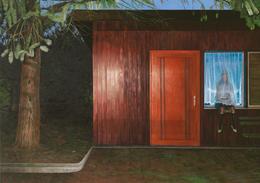
America 2005
Kalaizis grew up in communist East Germany, the son of Greek exiles. He has become a prominent member of the so-called New Leipzig School, and in 2005 he had his first extended stay in the United States. The paintings created that year, printed in the exhibition catalog "Rubbacord", combine Kalaizis’s typical subject matter: mysterious situations that allude to the presence of something eerie, something not directly pronounceable, with elements of American landscape and architecture. One understands immediately why these concrete and glass façades, not cold but just smooth and sterile, have found their way so easily into Kalaizis’s world of imagery; they meet his need for "purity and clarity of the background in order to provide a support for the scenarios which are not necessarily so obvious. What I need is the perspective order of space, the interaction of color, which includes the utilization of a strictly limited palette” (interview between Jan Siegt and Aris Kalaizis, "Rubbacord." p. 69). “Olentangy River I – III”, all in tondo format, show a river, strange concrete shapes in front of it or reaching into it, and vegetation in the background, on the other shore.
…the presence of something eerie, something not directly pronounceable
The contrast between two areas emerges quite distinctly: in the first picture of the series a clean concrete or stone curb encloses a very artificial lawn, where bright synthetic green, almost unreal, contrasts with the water, the dark trees and the pale blue sky and white clouds. The two areas, artificial and natural, are in indirect tension with one another; they negate each other. If one were to cover the lower part of the painting, a relatively peaceful piece of land remains, whose abyssal nature – indicated subtly by the different color of the flowing water and the black edge of the opposite shore – is accented only by the apparent “purity and clarity” of the foreground. It now seems strange how the foreground itself becomes somehow shady. Suddenly one does not trust the cleanliness and the peace any longer, and becomes aware of a menace somehow emanating from this foreground.
"An der Oper" [At the Opera]: a bright street, again a neat lawn, and the stone wall of a building with five rectangular openings, one perhaps a door, the other four windows in which, entirely unexpectedly, a dark forest is reflected. A path of sand leads up to the door, somewhat orange in color (introduced into the scenic composition like an extract from a piece of pop art). One would not quite dare to pass through it, for it may lead to an elusive twilight zone, like the entrance way in "Der falsche Weg" [The Wrong Way]. Does this dark area actually lie within this building, do the reflections show not what is without, but rather what is within, behind the façade?
This association is surely not wrong, though it may be misleading. Behind the smooth façade of consciousness, under the surface of the ego-shell lies rejection, ready for any kind of aggression – as established by the psychoanalytical approach. We Europeans are ever quick to the draw when tracing down the violent potential of the reified American society. Perhaps we make use of a theoretical construct which has long since become the subject of doubt. Perhaps Kalaizis plays with it without following its prior conditions. Let us take a closer look. The traces of a lawn mower on the grass in front of the opera lead directly to the window panes; as if the machine had driven into them, penetrating into the realm of the woods, so to speak. But this realm is not behind the painting, the painting itself is this realm. If we succeeded in perceiving the reflection on the panes, which in the first instance refers to a space lying outside the picture and then possibly to another one behind it, as its surface on which light and dark meet, we truly would turn into its beholders and would not any longer look for hidden objects in or behind it.
…does not lead into another area, but constitutes – together with the house front and its blue windows
The painting refers to its own surface, hence to itself. Thus, the entrance in “Der Falsche Weg [The Wrong Way]” does not lead into another area, but constitutes – together with the house front and its blue windows, the patch of grass, the street and the double figure of the girl with the anorak – its space on which or within which – its contrasting components meet. And "Die Nacht an jedem Tag" [The Night on Every Day], that continues to play and elaborate on the doppelgänger motif, already points out in its title that the night, the ominous clouds, the second, smaller house with the empty windows and, of course, the woman dressed in black standing in front of it, call forth the presence of darkness and mystery under the light of day, and subsequently do so for the inner eye. The intertwinement of contradiction presents itself as a composition of its own: The picture does not consist of painted objects but of layers and structures that form a “place” which produces “the occurrences" or the figures on which the attention focusses at first (interview, in: “Rubbacord”, p. 71); pointing to itself by means of its contents is an essential element of the picture's reflection. Therefore it does not mean anything else, for that which wishes to isolate itself as meaning withdraws and becomes part of its own existence. The painting thereby creates its own special reality. Of which kind? That will require further examination.
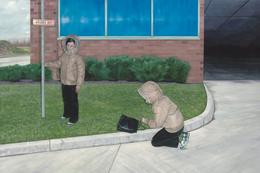
"But all works of art have only averted the total prevalence of bestiality, they have achieved nothing else.” (interview 1997, in: “Of gradual reconciliation”) – but how do art works accomplish this? Kalaizis gives the following important note: “Art is always a joy, whether or not I depict something cheerful or something tragic" (interview, in: “Rubbacord” p. 75). This joy arises, it comes with, no, it is the center of the inspirational process which structures the space of the picture: “waiting for that moment of celestial tranquillity when things finally fall into place" (interview 1997, in: “Of gradual reconciliation”). At this moment, to be concise, the "Inbild", (ib.) the picture's inner image, has arisen. For what can be seen on it is copies of the concept whence its existence arises.
The inner image emerging at the moment of tranquillity is the composition itself, the space in which it configures itself. We have already seen that for Kalaizis this inner image consists of an intertwinement of contradiction. Thus, the threatening and gloomy aspects have an essential function: without them there could not be any internal tension, no simultaneity of the apparently preclusive. Consequently, one may not immediately equate the idea of the nocturnal and black with the idea of the bestial. Rather, it calls forth the hidden presence of a realm of danger without which there could be no art at all. Painter or beholder, one who does not enter this realm by crossing a certain border, will only produce pale copies of reality or take their colored reproduction as pictures, even if one paints abstractly or uses subtly differentiated art-historical criteria for the analysis. The composition itself is invisible – it appears in the polarity of opacity and mystery, form and the unspeakable, as a surface or inner image of the painting. The observer must attain this composition as well, and one can only succeed if increasing the intensity of one's observation in order to take into consideration the equality of both contour and ambiguousness, as well as figurative composition and its reflection or self-abolishment. Indicating its surface, the picture reflects upon its existence and recognizes itself as the simultaneity of polarity.
The painter’s joy, which comes from such a self-knowledge of his or her creation, results from the perception of a certain parallelism of diversity, on the one hand excluding itself and therefore, on the other hand, communicating within itself. Indicating this simultaneity during the act of painting means to delve into the inspiration space of the inner image with an increased concentration and alertness and being present to what happens in an active-passive activity: "Am I the one doing the painting? Do not the ocean or the fire, the earth, my gender, the nation, the history, all speak through my work?" (interview 1997, in: “Of gradual reconciliation”) "Glee" and "tragedy" both are necessarily elements of the joy that accompanies the birth of art works. Within the developing era of the Nachmoderne that generates plural psycho-social structures, living within parallel situations becomes increasingly possible: today it is no more a difficulty for one to regard oneself as both free and constrained, religious and sceptic, emotional and rational, optimistic and frightened at the same time, indeed it seems the concurrence of contradictory feelings only fit the existence feeling of the present. Kalaizis’s paintings not only reveal the basic components of this feeling, they arise in its inner space and participate actively in the creation of the metaphorical world where this feeling expresses itself.
…they arise in its inner space and participate actively in the creation of the metaphorical world
In approaching Aris Kalaizis's paintings, initially some important components of the reality created by his pictures come up. Their ambiguous element is no longer to be deciphered as an unmasking of an existence deficient and self-alienated; it is on the one hand evidence of a necessary transgression of limits, on the other hand part of a tense relationship. As a whole, these form the area of nachmodern inspiration: intense joy, as imparted by the arts, is not the opposite of mourning – one who feels this perceives life as a parallel structure in which affirmation and denial, desire and pain, beauty and terror all suspend themselves in profound simultaneity. The “celestial tranquillity” that arises when the “characters find their home” within the “inner space” of the picture (interview, in: "Rubbacord.", p. 72) is nothing without its opposite, the constant threat of limit-transgression, (it is the opposite of “civil geniality”, "Rubbacord", p. 63). The reality of the pictures which Kalaizis paints is integrated into the one of nachmodern structures both contain or are juxtapositions of fright, "bestiality" and affirmation of existence. How can such contrasts exist in such an undiminished sharpness at the same time – in the present? One taking this into consideration is looking at the mystery of nachmodern life itself that confronts him or her in the images produced by this life.
The new paintings, painted in 2006, largely neglect American imagery, except for in “Das Holzhaus” [The Cabin]. But there has been a change in the composition which perhaps has benefited from the experiences of Kalaizis's stay in the USA. Though the artist’s wife and daughter are his preferential models they are staged in a matter entirely different to the works of 2004. Since we know now, that the figures are yielded by the space in which they are located, we first lay our eyes on the space and only then on the figures within it.
…both contain or are juxtapositions of fright, "bestiality" and affirmation of existence
“Am Ende der Ungeduld" [At the End of Impatience]: a room with high walls and likewise very high windows, covered by curtains, a light to the left and right of them, and below each a radiator; at the left wall a queen-size bed with rumpled sheets – everything dipped in an intense green light of an unidentified source. Except for the bed, everything exists twice, so the bed creates a difference in the double spatial structure. Therefore the almost naked young girl lying on it calls for a counterpart that restores balance and, at the same time, in apparent contradiction, marks her own nullification. The doppelgänger of the figure lying in prone position is standing on the right by the wall, absent-mindedly staring at the radiator and the wall.
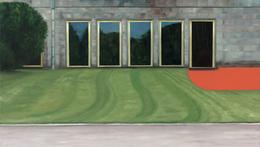
The title of the picture suggests first sexual contact. The figure, separated from her counterpole, the soul of the still-sleeping body, muses about what has happened to her; in the future, this girl will exist in duality, with her physical-emotional needs and desires and the vague memory of something irretrievably lost. Behind the standing figure, a threatening shadow looms, produced, unsurprisingly, not by diffused daylight but by an unreal source of light, situated by the bed. Melancholy and a certain initial lasciviousness, which the observer believes he must resist, likewise characterize the picture’s atmosphere. We are confronted with a scene of utmost intimacy and are appalled by the pictorial rigorousness with which it is presented to us. To a much greater extent, compared to earlier works, something entirely personal (though not, in this sense, biographical), the body-soul, is disclosed to open access and transformed in painting. "Am Ende der Ungeduld", the Nike-pictures, and a fortiori "Am Morgen danach" are clear transgressions of limits: they use something forbidden in order to produce a realm in which the question about the conditions of nachmodern art presents itself candidly. The question becomes a metaphor of its own answer.
"Nike" and "Nike II" repeat, paradoxically, the doppelgänger-motif of "Am Ende der Ungeduld", by allocating it to two pictures. The first picture again shows the exhausted girl presenting her skinny body in an unwitting gesture, apparently sleeping; it is the body of a pubescent girl as not only the small breasts reveal, and yet it seems somewhat worn or wasted, and, at the same time, somewhat old. Eros appears at once as youth and as time. The left hand – and the left foot – protrude into the foreground. This hand seems worn out, the skin is reddened in places, the fingers those of an adult rather than of this child. The observer's gaze will naturally flit over the nether region, especially when trying to avoid it, and the girl's crotch is not so much hidden as emphasized by the lone garment covering it. But more than that, and more than the almost-crude facial features with closed eyelids, that give an idea of the inanimate eyes through a narrow gap, as it sometimes is with children in deep sleep, this very hand provokes a deep feeling of shame. To me, there seem to be two reasons. On the one hand, the raw, irritated skin evokes the thought on an early sexuality in the girl and thus arouses the association of an innocent corruption of the natural, which combines in turn with an association of exploitation and abuse; on the other hand, the blunt depiction of the ugly or at least unpretty appears strange in a subject which should, from a classical modern point of view, express the opposite – if not beauty, then at least innocence.
The painting reveals itself as indecent in more than one respect. At first glance its counterpart, "Nike II", rather fulfills the demands of traditional aesthetics. The girl seems to look for protection and security in the small armchair, apparently absorbing her. But at the same time she allows a view of her unwitting nudity. If one looks closer, one remarks that there is no connection between the resting body and its surroundings. The dark leather of the armchair shows not a dent; the girl – body, head and arms – does not leave any impression. The material remains as if untouched. One is concerned: One starts to feel sorry for the child, who in fact is not a child any more; apparently that which should grant her protection poses a threat. But then is not her calm, relaxed pose all the stranger? Either she does not feel the coldness of her surroundings, or she is unimpressed by it. Anyway, closeness and distance are presented in an unusual relation here. They seem to coexist in a most paradoxical way otherwise regarded as impossible.
The sleeping and yet apparently pondering girl, the double of the exhausted one resting in a naïve lascivious pose, seems lonely, but not at all unsettled or hurt. She rather seems composed, her face showing something unapproachable or self-reflected. Suddenly one understands that this figure does not at all represent the innocence lost by her counterpart. Her melancholy does not result from any kind of harm, be it of an abhorrent nature or otherwise. She rather seems to express an awareness of the corporeality of her own existence. It is exactly this knowledge, and less a remembered regret of the loss of innocence, that would befit the other girl, the counter-image, as one can state now looking once again at "Am Ende der Ungeduld". This is no confrontation between a natural state and the loss thereof, but it is shown that life – also and especially in its early stages – already involves an ambivalence. This expresses itself as a mysterious simultaneity of desire and liberty, drive and beauty, affirmation of existence alongside a deeply melancholic alienation from it.
The ungraceful pose of "Nike" refers, by way of omission, to the postures of female nudes in paintings, developed during antiquity and then particularly during the Renaissance. "Nike II" communicates with them more directly. The composure of the painted body shows more than just a trace of beauty. But if the knowledge of these youthful figures: that of the picture itself, containing the parallelism of the different, as well as the parallelism of beauty and its opposite. Both meet in the communicative undercurrent of the pictures: "Nike" and "Nike II" are in fact a diptych, whose immanent serial nature extends even further. For that which is plural in character and contains the simultaneity of ambivalence longs to form self-referencing fields of metaphors. The inner images of Kalaizis’s painting communicate with each other by being mirrored in their different arrangements.
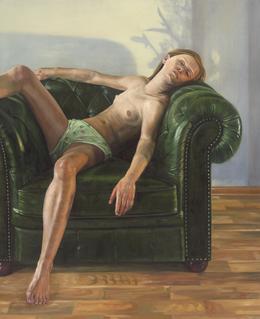
The doppelgänger motif which so frequently appears in these pictures, consequently expresses their inner momentum and not only an external topic. It develops communicative structures which extend into space and into time. The female figure’s postures or gestures indirectly refer to those of the Renaissance and the Baroque, which thus enter the picture surface and pull it into a temporal stretching process, the counterpart of the spatial stretching process, which lends the series or fields of metaphors. By this self-reference, by pointing to its surface and thus becoming reflexive, the picture expands its surface: its reality does not cover only communicative references to other structures of the present and to epochs evidently far gone, but also shares in a certain way a decisive characteristic of the nachmodern era – that which reveals itself to be a painting by the parallelization of its polar structural elements, thus referring to its contents just as such elements, themselves devoid of meaning, transforms its existence into virtual reality.
It is real provided the permanent indication of existing in a virtual space, as inner image or mystery (which in painting and literature is the same) of a paradoxical simultaneity of contradictions.
It requires concentration, intense alertness of observation, to bring forth the covert simultaneity, the actual composition in the configurations of the picture. "Deafcon No. 1" (an untranslatable title, apparently formed from the components of two languages) makes the process of its emergence a topic of its own. The painter is apparently located in an imaginary room whose walls shine green as if from within, but look – not only because of this – like the set of a movie. On the right, the shadow of his left arm can be seen. The shadow of the other arm lies apparently on an open door which, however, reflects the brightness of a light source situated outside the room – but then the shadow cast on the door cannot belong to the man, whose raised arm forms another angle altogether. Thus, we are confronted with a duplicity, its elements originating from different layers: that which the painter wishes to find on the surface in front of him – his divided self – lies behind him.
The floor seems to swallow the wall’s green gleam. Only next to the figure's naked feet, below dark trousers and white undershirt lies a reflection – some light breaks in out of the corridor on the right, but otherwise the parquet seems like a black mass, not a solid base, but rather some dangerous void into which one may sink at any time. For the painter apparently the wall’s surface becomes that of an imaginary picture which shall emerge in the light of the lamp he holds; he himself, however, has already approached it. Remembering Kalaizis’s statement, it represents what has not yet emerged on the surface and what the painting transposes into its space. The two communicate with one another. The apartment room thus becomes a place of imagination which begs to collapse into a form and make itself visible; this form is, however, the painter who thus lets the interior of his inspirational process become a painting.
The surface, so intensely observed and scrutinized, extends and becomes a space, which reveals itself in turn to be imaginary, therefore in virtual reality. The actual reality of the picture is its process of virtualization. Its topic is the nachmodern connection between inspiration and reflection. The production of this relationship offers the observer an insight into that process of the models of society's psycho-social structures now forming. The nachmodern inspirational space just cannot be reduced to its technical-instrumental components. It rather puts contents into a communicative relationship on a shallow surface which are paradoxical and apparently reflexively exclusive. One of the most important tasks of contemporary art is to make them visible in their simultaneity of contradictions. Kalaizis’s painting confronts the task by making it its immediate subject.
Modern transgressions of limits have always aimed to break taboos. At the beginning of the twentieth century, this was made especially clear, as exemplified by expressionism and abstract art. The transgressions of today, however, follow a different rule. Just the confrontation with the prohibition of incest, center pillar of the social structure of ages past, does not aim to attack and overthrow a center of the structures of social order any more. Concentrating intensely now on the paradoxical simultaneity of the mutually preclusive, one crosses a line, breaking off from the modern age's removal from the present, from this age's inhibitions and prohibitions. To understand reality in a way that no longer strives to achieve some good and just utopia, we turn away from all ethic and aesthetic principles of modernity. We acknowledge the same validity in violence and in the desire for peace, in fear and in joy, in the purpose underlying our existence and in the lack thereof. The danger the painter depicted in “Deafcon No. 1” exposes himself to is no longer just getting lost in the unbound Dionysian energies of the unconscious; it is to look something monstrous in its strange eye, namely that this world is infinite and does not have any exit, inexhaustibly dynamic in the boundless combinations of its structures; and confronting this richness of possibilities is a merciless death, making any thought of salvation impossible. To withstand such paradox and to put it in painting is the task which the artist has to face – a task which requires utmost concentration.
The most disturbing painting in the series is doubtlessly “Am Morgen danach”. Pink and green tones dominate it, moderated almost to the point of being tolerable only by the brown parquet flooring. A girl dressed only in underwear is looking for protection from a woman, perhaps her mother, who does not, however, even raise her arms, remaining coldly distant. Her pointed face and closed eyes lead to a slightly protruding mouth and a bony chin, a tense cheek muscle in the clearly accented right side of her face, deepening the crevice that runs across the cheek: clearly, the distant attitude either takes a great deal of energy, or it is so deeply ingrained that it turns the face into a mask. The girl’s face recalls that of "Nike II". She seems wary, as if she wants to remain collected at all costs, not to let out whatever it was that happened to her teenage body and soul over the night before this morning.
In front of the two kneels a man in a brown jacket, his shirt the same color as the underwear of the child, who is, perhaps, his own. The strong eyebrows and the down-turned moustache, and, moreover, his eyes, fixated on his hands in horrified fascination, make him look somewhat diabolical. One might suppose this is the perpetrator, who has wronged his own daughter. On the right, a strange beam of light, somehow double or crossed, falls through an open door onto this scene, in which an intensely cold and lifeless atmosphere harshly meets one of intimate warmth. Again, we are in an interior, looking directly at the externalized emotional texture of its characters.
It seems the painter’s access to his child-cum-model, culminates here in ruthless obscenity. Kalaizis puts his own family into an incestuous situation and clearly intends to artistically utilize the taboo which has grown stronger yet with the decline of the modern age, and which society has erected against child abuse. If one cannot successfully use the interpretation described above to analyze this painting as well – if its graphical themery remains untouched by the inner intention which it strives to integrate – then the attempt to interpret Kalaizis's work as the expression of nachmodern internal images has shown itself to be mistaken. However, there is indication that the topic of incest gives rise, in turn, to another one.
The hands the man is looking at belong to a painter: it is them that created the painting in which they are shown. The cross of light on the floor surely indicates a long tradition, in which the passion of the crucified and that of the artist are parallelized. This culprit, who makes his child his model – whose mother, having suffered the same fate, cannot help her – is at the same time one suffering from his own guilt, which is, indeed, the precondition of his work. The horror and fascination in producing such a work, expresses itself in a metaphor that inevitably contains the core of nachmodern tabooing. By becoming the impersonation of the worst contemporary society can imagine, the artist reaches the area of utmost danger and exposes himself to it. This is what an inspirational figure could look like in today's paradoxical present. It combines elements most contrasting and gives a surface the space in which the mystery of life paints and reflects upon itself. If such a parallel situation appears, the most intensive joy, beauty and fright meet in view of the greatest breach of taboo imaginable – its constellation becomes a composition for the expression of the metaphysical (though not at all ontological) truth of the twenty-first century.
(Addition. Looking at the door once again, the metal bar as well as the indentation on the lower edge stand out, which, moreover, floats a bit over the ground. Kalaizis clarifies this to be a refrigerator – obviously one of the large variety very common for America – in which something is hidden; the daughter seems to know about it, the mother suspects the deed. "But there isn’t any hint to a morning, a morning light and no awaking and thus no solving…" This note indicates a different though related painting-reality. Both can definitely coexist, and neither that of the interpreter nor that of the painter must call for the supplantation of the other.)
The inspiration-space is a virtualized one. The metaphors of truth which were portrayed in Renaissance art as appearances of beauty and which in the modern age, survived as distorted metaphors, in which the longing for the opposite concentrated in its ugliness, have been subjected to another metamorphosis. To Marsilio Ficino, the great Neoplatonic philosopher of the fifteenth century, visible beauty was the appearance of the invisible divine beauty. This longing for visible beauty actually aimed for the latter – without even being aware of it. Erotic desire, spurred on by the materialization of the ideal, revived and escalated up to the search for the origin of this beauty. What once was called Muse, has consequently been the picture of an incarnation which steered the inspirational capability of the artist to his center. Does this relation still exist, which preserved itself through all transformations, including those of the twentieth century, or has it changed so fundamentally that one can no longer say of it that it has changed its shape, however radically?
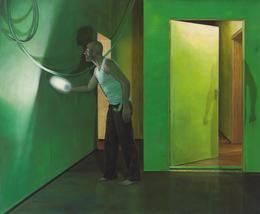
"Psemata": A naked woman sits in front of a mirror and looks at herself. No, this is wrong. When looking more closely it becomes clear that what we see before us is a staggered painting. The first one shows another one; the mirror turns out to be another painting, for one gets the impression the arrangement of the oval area surrounding the head and upper parts of the woman’s body and the open window can not actually portray the foreground of the picture in which the nude back is situated. Picture or mirror – or both? When this question arises one understands at the same moment that the difference is only apparent; the mirror is painted as well. Arm and hand of the nude reach out to an enamel bowl as if she wanted to wash herself; but within the bowl, the sides of which one cannot see through, there seems to be sand. Kalaizis says, Psemata signifies "something like: a lie, not the truth…” – the picture is not, and therefore is, what it shows.
It is namely the demonstration of the statement characterizing it: being a picture and being a picture once again, hence the reflection intentionally turned towards itself. It says, I am not a thing which refers to an objective reality, or rather assume such a reality reference and reintegrate it into my being, which is appearance. The naked body, simultaneously showing itself to the obsever and refusing to, being virtualized, shows its face in pictorial reflection looking at us – no, at first not at us but at the painter – with a look of attentive insistent scepticism. The figure asks her creator by what means he stages her. She is giving herself away and yet withholds herself, just like Kalaizis says of himself in another context: "One gains strength by never fully revealing oneself, by a certain reservation." (interview, 1997). In the older works, the black dressed woman holding a black bag before her belly and thus before her nether region stands for such a unity of exposure and denial. However here, in the newer painting, another component is added in, which forces open the earlier scheme. Not only the model, the picture itself, its inner image, ask the one who created it for its form of existence – the painter who so raptly studies the wall in "Deafcon No.1" would find the explanation he seeks in this look.
If he will stand up to this stare – and exactly this is his task – a communication would be enabled between the inspiration and its inner object that could not be more intense. The object asks the inspiration to leave it be; the painter would thus become a tool for the creation of his picture. Its contrasting elements – the drive to devote and the drive to refuse – ask for the creative awareness which helps them both to achieve expression. Distance and closeness do not cancel each other out in it but enter into a relationship of tension. And now it is as if the painted eyes, in their scepticism, reflect the alertness which they require. If the distance can seem as naked and bare as the closeness does, then both will become a sign of a last intimacy without merging in any way. In its emotional space, existence reveals its love for us and its irrevocable strangeness. Both look at us out of the painting; understanding this, the naked body, its skin shining in crude but warm yellow light, with its accented bones and tendons as well as the traces of welts – left behind, perhaps, by clothing – become an appearance of nachmodern beauty. This beauty is not based on an external center, it is rather quite present and thereby real as well as virtual-reflexive. This moment intensifies the other moment although there is no harmony between them.
So in turn there is a possibility of an intimate encounter with existence itself. In this encounter, existence contracts into an experience of beauty and in parallel that of distortion and destruction. Kalaizis’s painting grants us access to both by its surface's ability to stretch into intermediate layers, those of the imaginary space of inspiration, whence appear the configurations and shapes of the nachmodern world in which we live. Today, no art can immediately represent the codes of beauty as in the Renaissance era.
But also the attempt made in the last century to survive the ruthless distortions which have happened to it in the historical process, the utopian inclinations for its regeneration, cannot be continued any more. The aim it envisaged revealed its clear totalitarian potentials – which is the real reason why that impulse does not carry on any longer. Thus it is the task, to offer beauty in existence and in the arts (both are mutually dependent) a new place – but the one it chooses itself – under fundamentally changed conditions. The painting of Aris Kalaizis is not merely seeking for it any longer, for it has already discovered this space and is now going to populate it with the paradoxical contents it calls for.
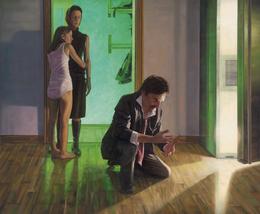
(Source: Philosophia-online.de)
©2007 Max Lorenzen | Aris Kalaizis
Max-Otto Lorenzen, born in 1950, was a philosopher and writer, as well as the founder of the Marburger Forum. He died in Marburg in 2008.
Ib. For a while, Max Lorenzen has been working on the paper “Philosophie der Nachmoderne”, a philosophy of Nachmoderne. The term Nachmoderne does not refer to the postmodern era. Nachmoderne is the era following the postmodern age, while accoring to Lorenzen’s idea postmodernism itself is yet a part of modernity. Then, nachmodern aesthetics signify aesthetic parallel experiences which are symptomatic for our age.
Nachmoderne can be defined as new society structure that has been developing since the nineties of the last century, increasingly embracing the psyche of man. What would be deterioration from modernity’s point of view, creates fields of metaphors with stand-alone morals such as the parallelizing, co-existence or simultaneity of the apparently preclusive, of polarity or contradictions. Central structures that have been valid up to the end of modernity are now replaced by plural psycho-social structures that do without a core or center. The consequences for morale and ethics, as well as for an aesthetic of the present time, are incalculable.